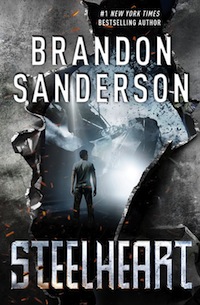David, the young protagonist of Brandon Sanderson’s upcoming YA novel Steelheart, is a devout cataloguer. Faced with the constant threats posed by the Epics, the superpowered beings who have come to dominate mankind, he has responded with spreadsheets, tier charts, and homebrew power categorization systems. The huge volume of data, statistics, and speculation he collects would make any RPG designer or Fantasy Football enthusiast salivate. David scavenges his data from every conceivable source: rumors, questionable newspaper articles, and life-threatening fact-finding missions. The result is literally reams of paper, contraband literature that David has risked his life to create—and will risk it again to keep hold of and out of the hands of his Epic oppressors.
I may sound like I’m poking fun at David and his meticulous homebrew spreadsheets. Well, I kind of am. His earnest devotion to his categories and systems amuse me. But this research serves a vital purpose, and brings David into noble company among Sanderson’s growing gallery of characters. Researchers grace the pages of most of Sanderson’s novels. Vin’s explorations into the various allomantic properties of metals and alloys and Sazed’s devoted search for metaphysic and historic truth drive the plot of the Mistborn series both mechanically and emotionally. Shallan’s entire arc in The Way of Kings comes down to winning and then maintaining a research fellowship, and she and her mentor Jasnah spend almost all their time reading books in a library. Which, by the way, is absolutely riveting, I promise you. This comes to a head with Joel, the protagonist of Sanderson’s previous YA offering The Rithmatist, who is a grade school student trying to come to terms with a magical and cultural system he’s been excluded from by research and experimentation. Even when Brandon Sanderson doesn’t write researchers directly into his stories, their spirit remains. Such is the case in The Alloy of Law; what is a detective, anyway, but someone who researches crimes?
Sanderson has often been pointed to as one of the most systematic and thoughtful worldbuilders writing today. He makes worlds that are complicated, intricate, alien from our own and from each other, and always internally consistent. Such worlds reward researchers. They exist in orderly ways that can be explored through intelligence, sense, and persistence. They reward methodical thought and diligent effort but leave room for inspiration. The application of hard work in an intelligent and thoughtful way, Sanderson’s canon argues, is the truest form of magic—it’s the spark that drives mankind beyond mundane and benighted stumbling through an incomprehensible universe.
That is quite literally true in the Sanderson’s Hugo-winning novella The Emperor’s Soul. Shai, the captive protagonist, is the master of a magic that requires absolute understanding of its subject. She has the potential to transform almost any object, in ways big or small, but to do so she must know all its properties. She can even rewrite a human soul, changing her subject fundamentally. By constructing the narrative of the Emperor’s life, learning not only what he was and who he was, but also why he was those things, she can recreate his identity.
 The drive to understand wasn’t always the focus of the fantasy genre, and the magic of our earliest fantasy worlds was intentionally vague. The power wielded by Gandalf the Grey in Tolkien’s worlds was vast, but limited. It is not for hobbits or humans to understand. Even the power vested in the artifacts of Middle-Earth was vague. The One Ring was corruptive because it was an allegory for power-lust, and in that way it was extremely effective. But what power was actually available from the Ring? Invisibility is an extreme social power, but not enough to topple kingdoms for. Rings of invisibility in modern fantasy are often massively outclassed by the other artifacts that casually rewrite the laws of physics, and an Epic who only possessed invisibility would barely crack Tier C in David’s charts.
The drive to understand wasn’t always the focus of the fantasy genre, and the magic of our earliest fantasy worlds was intentionally vague. The power wielded by Gandalf the Grey in Tolkien’s worlds was vast, but limited. It is not for hobbits or humans to understand. Even the power vested in the artifacts of Middle-Earth was vague. The One Ring was corruptive because it was an allegory for power-lust, and in that way it was extremely effective. But what power was actually available from the Ring? Invisibility is an extreme social power, but not enough to topple kingdoms for. Rings of invisibility in modern fantasy are often massively outclassed by the other artifacts that casually rewrite the laws of physics, and an Epic who only possessed invisibility would barely crack Tier C in David’s charts.
As the genre matured in dialogue with RPGs, more and more writers began to produce magic that was less ineffable and more systematic. The function of the “wizard” began to shift from the mysterious old man whom it was best not to approach, let alone inhabit from a narrative perspective, to the young person feeling his or her way through a mysterious world with rules that weren’t yet explained, but which could be mastered. For example, Ursula K. Le Guin’s Ged became the master of strange and numinous magics, working through how to harness magical power. The true name magic of the Earthsea Quartet was still essentially incomprehensible to readers, but it was nevertheless something for wizards to learn, to struggle with. It was a step closer to research.
The One Power, Robert Jordan’s system of magic in the Wheel of Time series, was yet more detailed. Jordan wrote researchers, scientists, people who longed to rediscover old techniques and technologies and who devoted their time to doing so. Even then, however, almost all of the important discoveries in the Wheel of Time came through guesswork or happenstance, and usually happened off screen. It could be said, perhaps, that Elayne’s experiments with ter’angreal were scientific, but not that they were rigorous, especially when compared with Vin’s metallurgic trials. I’m pretty sure Vin at least took notes of her progress.
In some ways, I think that more scientific magic (or superpowers, as the case may be in Steelheart) is less magical than what came before. Despite the old adage about sufficiently advanced technology, science and magic probably shouldn’t actually be synonyms. But I love the researcher character, and the research plot. And while I doubt researchable magic is enough to sustain my epic fantasy tastes forever, I can’t think of a better fit for it than in YA fiction, where the young protagonist’s quest for self-understanding can parallel their drive to uncover the secrets of the world they live in.
Carl Engle-Laird is an editorial assistant, Way of Kings rereader, and resident Stormlight correspondent for Tor.com. He would probably read David’s notes if they were put in front of him. You can follow him on Twitter here.










